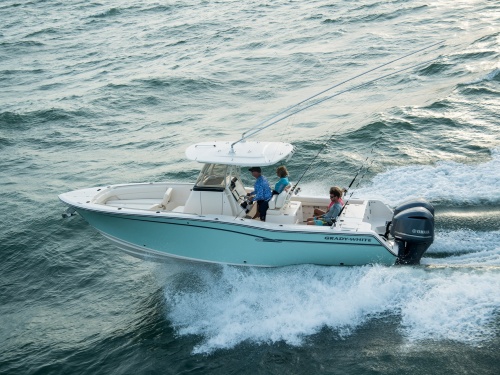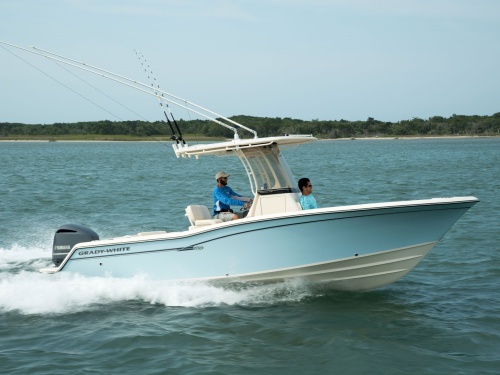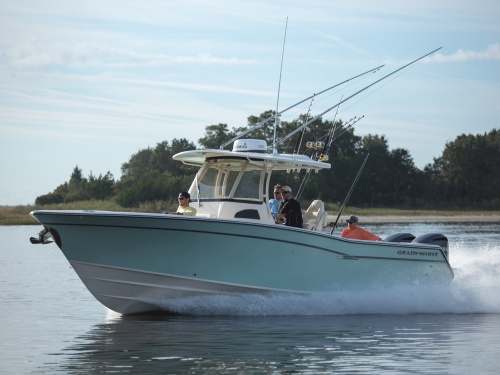Access More Boat Tests
Already have an account? Login
Grady-White 281 CE (2023-)
2 x 300-hp Yamaha Four-Stroke
Brief Summary
The 281 CE is not just another warmed-over center console but a boat that the design team put a lot of thought and effort into. And to be frank, it shows. She’s loaded with thoughtful features and improvements over typical designs that we usually see.
Test Results
| RPM | MPH | Knots | GPH | MPG | NMPG | STAT. MILE | NM | dBa |
|---|---|---|---|---|---|---|---|---|
| 600 | 3.6 | 3.1 | 1.5 | 2.4 | 2.1 | 341 | 296.3 | 62 |
| 1000 | 5.7 | 5 | 2.8 | 2.1 | 1.8 | 298 | 259.5 | 68 |
| 1500 | 7.9 | 6.9 | 4.5 | 1.8 | 1.5 | 256 | 222.3 | 73 |
| 2000 | 8.9 | 7.7 | 7.6 | 1.2 | 1 | 169 | 146.6 | 77 |
| 2400 | 12.9 | 11.2 | 9.7 | 1.3 | 1.2 | 192 | 166.5 | 84 |
| 3000 | 23.3 | 20.2 | 12.1 | 1.9 | 1.7 | 278 | 241.6 | 88 |
| 3400 | 32.1 | 27.9 | 14.7 | 2.2 | 1.9 | 316 | 274.4 | 86 |
| 4000 | 38.6 | 33.6 | 21.2 | 1.8 | 1.6 | 263 | 228.5 | 86 |
| 4500 | 42.2 | 36.7 | 25.5 | 1.7 | 1.4 | 238 | 207.2 | 85 |
| 5000 | 46.8 | 40.7 | 33.2 | 1.4 | 1.2 | 203 | 176.5 | 91 |
| 5500 | 52.4 | 45.5 | 44.4 | 1.2 | 1 | 170 | 147.8 | 88 |
| 6000 | 55 | 47.8 | 55.3 | 1 | 0.9 | 143 | 124.4 | 107 |
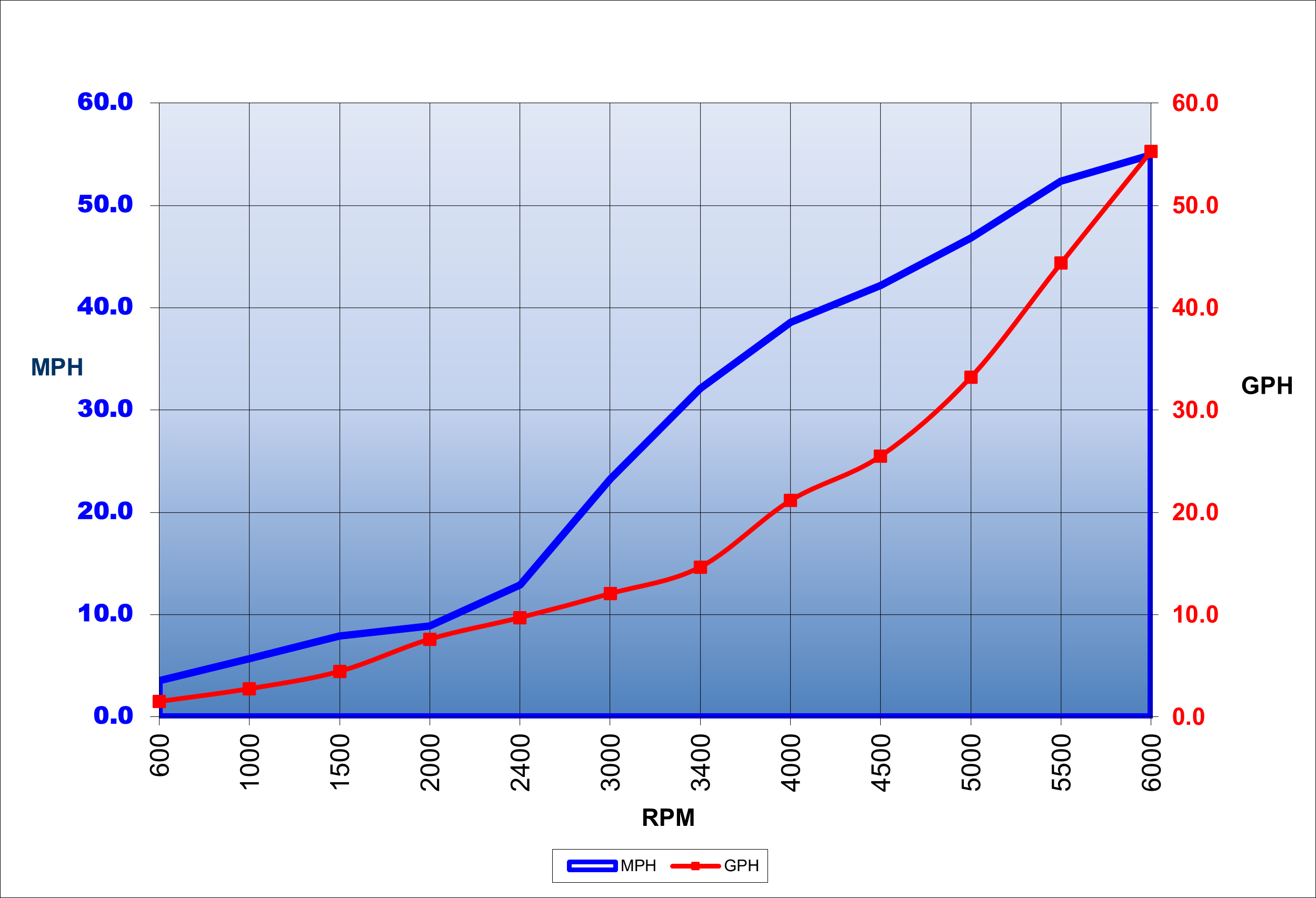
Specifications
| Length Overall |
27'7" 8.41 m |
|---|---|
| Beam |
9'4" 2.84 m |
| Dry Weight |
5,650 lbs. 2,563 kg |
| Tested Weight |
8,103 lbs. 3,675 kg |
| Draft |
19" 0.48 m |
| Deadrise/Transom | 16 deg |
| Bridge Clearance |
7' 11" 2.41 m |
| Fuel Capacity |
160 gal 606 L |
| Water Capacity |
18 gal 68 L |
| Total Weight |
8,103 lbs. 3,675 kg |
Acceleration Times & Conditions
| Time to Plane | 3.0 seconds |
|---|---|
| 0 to 30 | 7.5 seconds |
| Props | 15.25 x 19 |
| Load | 3 persons; 112 gal. fuel; 50 lb. gear |
| Climate | 82 deg., 74 humid; wind: 0-5 mph, seas:<1 |
Engine Options
| Tested Engine |
2 x 300-hp Yamaha Four-Stroke |
|---|---|
| Std. Power |
1 x 450-hp Yamaha XTO Offshore |
| Opt. Power |
2 x 300-hp Yamaha Four-Stroke |

Mission
Being a Grady-White, the mission of the 281 CE is fishing first. Her offshore pedigree can carry a boatload of anglers well offshore in safety and her Carolina-flared bow will keep the ride dry.
Then it’s an easy transition to a family cruiser heading off to a weekend sandbar or waterfront restaurant.

Major Features
- Electrically-actuated foldout portside platform with reboarding ladder
- Deluxe leaning bar with rigging station
- Standard T-top with spreader lights, storage net, rod holders and LED lighting
- Transom bench seating
- Engine flush system
- Dual 70-qt (66.2L) bow fishboxes
- 18-gal (68L) livewell
- Electrically-actuated bow lounge backrests
- Molded forward console lounge seat
- Standard anchor windlass
Performance
The Grady-White 281 Coastal Explorer has an LOA of 27’7” (8.41 m), a beam of 9’4” (2.84 m) and a draft of 19” (48.26 cm). With an empty weight of 5,650 lbs. (2,563 kg), 70% fuel, three people onboard and test power, we had an estimated test weight of 8,103 lbs. (3,675 kg).
With the twin 300-hp Yamaha outboards turning 15 ¼ x 19 props and run up to 6000 RPM, our speed topped out at an average of 55 MPH. Best cruise was found to be at 3400 RPM and 32.1 MPH. At that speed, the 14.7 GPH fuel burn worked out to be 2.2 MPG and a range of 316 statute miles, all while still holding back a 10% reserve of the boat’s 160-gallon (606 L) total fuel capacity.
In acceleration tests, we reached planing speed in an average of 3 seconds, continued through 20 MPH in 5.5 seconds, 30 in 7.5 and onward past 40 in 9.6 seconds.
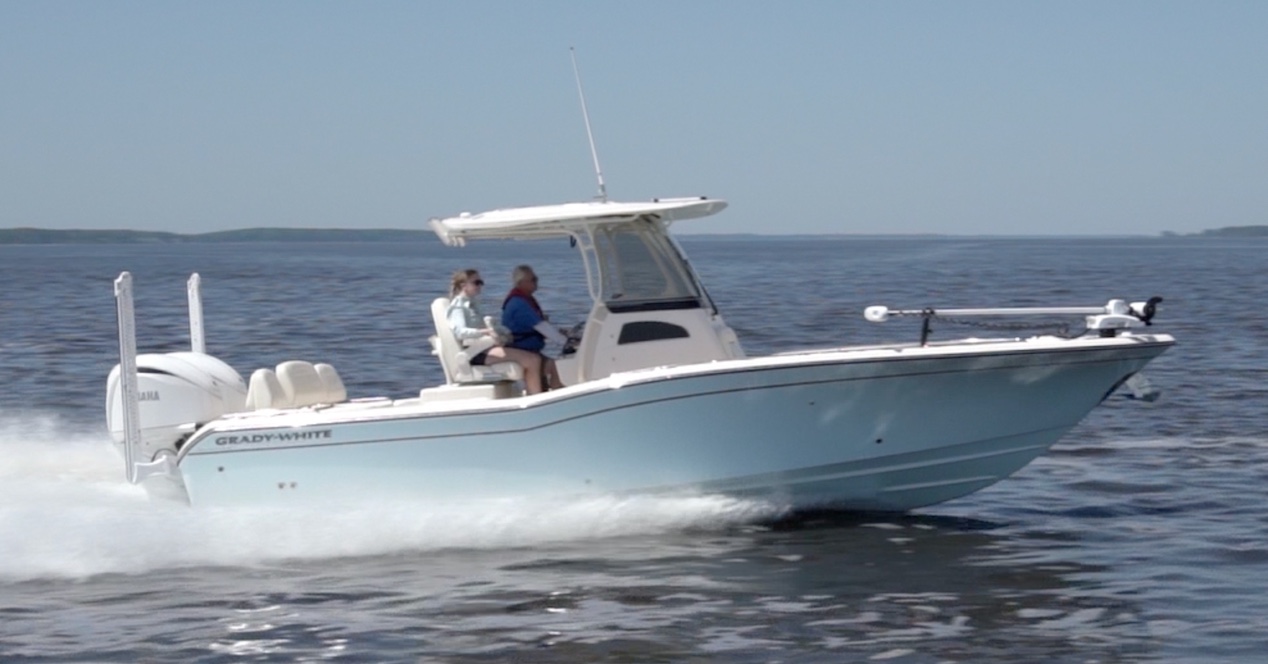
Handling
There’s so much to like in a Grady-White, but at the top of the list is handling. This feels like such a strong and sturdy boat. Its robust construction can really be felt all the way through the boat.
We had a flat calm test day, but crossing our waves, crossing the wake of the camera boat… showed clean transitions through the waves and no hull slap. We could generate a hard slap at top speed but that's not how you want to drive this boat. You want to slow a bit into cruising speed, and at that speed, she's able to push right through the waves and throw them aside and keep a nice dry ride thanks to that huge Carolina flare.
Putting it into turns, she leans nicely into the turn with a gentle roll so no one’s getting pushed to the outside of the turn. She'll lose about 2-3 MPH during the turn, which isn't bad at all, and can easily be accommodated by adding a little bit of throttle.
As far as trim is concerned, she does like trim. Bring the trim gauge up to the point where there are only about three indicators left showing, and that's the easiest way to do it. That puts her into a nice cruise attitude. Trim tabs are only used for an uneven distribution of weight. I didn't need them for performance at all.
Boat Inspection
Being a Grady-White, the models all start with fishing first. Here those features start in the cockpit with the Deluxe Leaning post that includes a 38-gal (143.8L) livewell behind the dual seats. Right alongside that is a self-draining sink with a pull-out spray right next to it. That sprayer is plumbed to the 18-gal (68.13L) fresh water supply. Below there’s plenty of tackle storage. To the port side, there’s a raw water washdown connection with a cargo net storage in a recess to hold the coiled hose. More storage and a tool holder are in a compartment to the starboard side. Around to the front, and under the seats, there’s drawer storage.
Above the sink and livewell, there are four rod holders and four more are at the trailing edge of the fiberglass hardtop. This is in addition to the eight rod holders lining the caprails and three horizontal rod holders to the starboard gunwale will holds rods up to 10’ (3.04m). Once the catch is brought onboard, it’s stored in the dual 70-qt (66.2L) bow fishboxes are insulated and self-draining. There’s also 296-qt (280.1L) coffin box storage under the lounge ahead of the console.
As for where we’ll be conducting the fishing, there is the cockpit of course, with its 21” (53.34 cm) high bulwarks for added safety. Aft of the cockpit there’s the elevated transom casting platform. It measures 7’2” x 2’2” (2.18m x .66m) and includes flush-mounted hardware. Another attractive feature of the stern is thanks to the new Yamaha digital integrated electric steering that’s integrated into the outboards. That means no hydraulic lines protruding from the engines and no need for a motorwell. So, in effect, we have another casting platform right up to the outboards. Additionally, if we swing the pedestal-mounted seatbacks outward, then we have side-leaning bolsters to enhance the usability of the area.
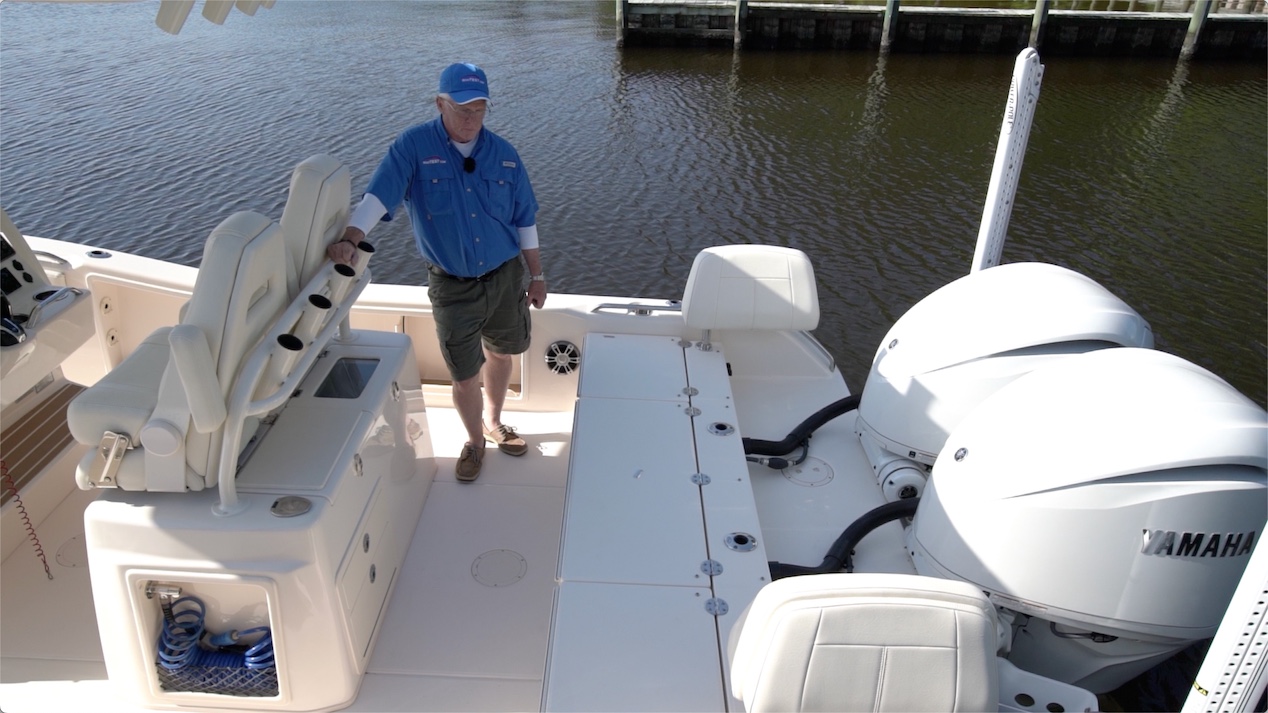
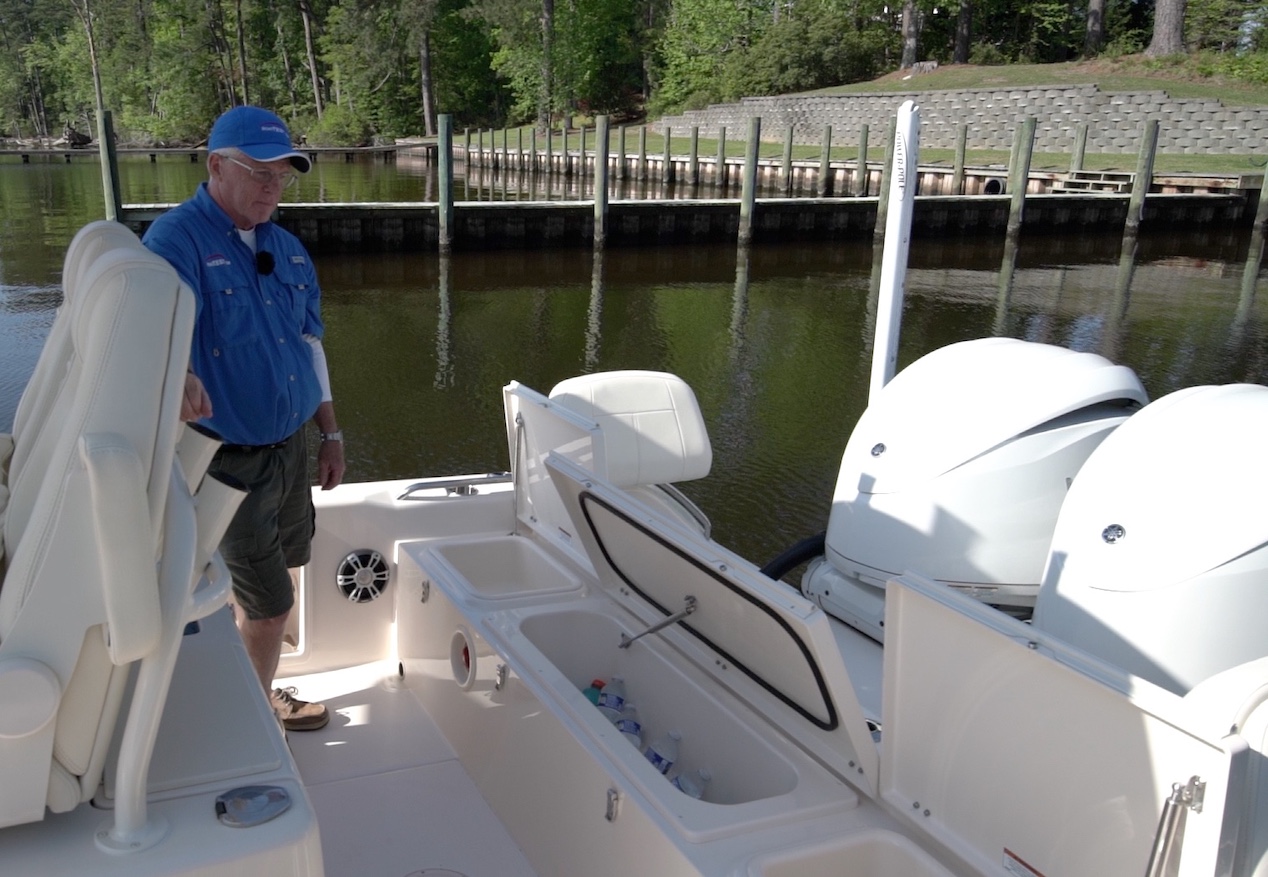
There’s another casting platform at the bow — this time a full 6’10” x 8’10” (2.08 m x 2.7 m). It's created by adding a filler section in between the two side lounge seats and then another filler piece goes in between the forward section and the lounge ahead of the console. It’s important to note that this platform is now 18” (45.72 cm) of the main deck, but instead of having to negotiate that large a step, Grady-White simply added another 9” (22.86 cm) step halfway up, making it much easier to step up onto the platform.
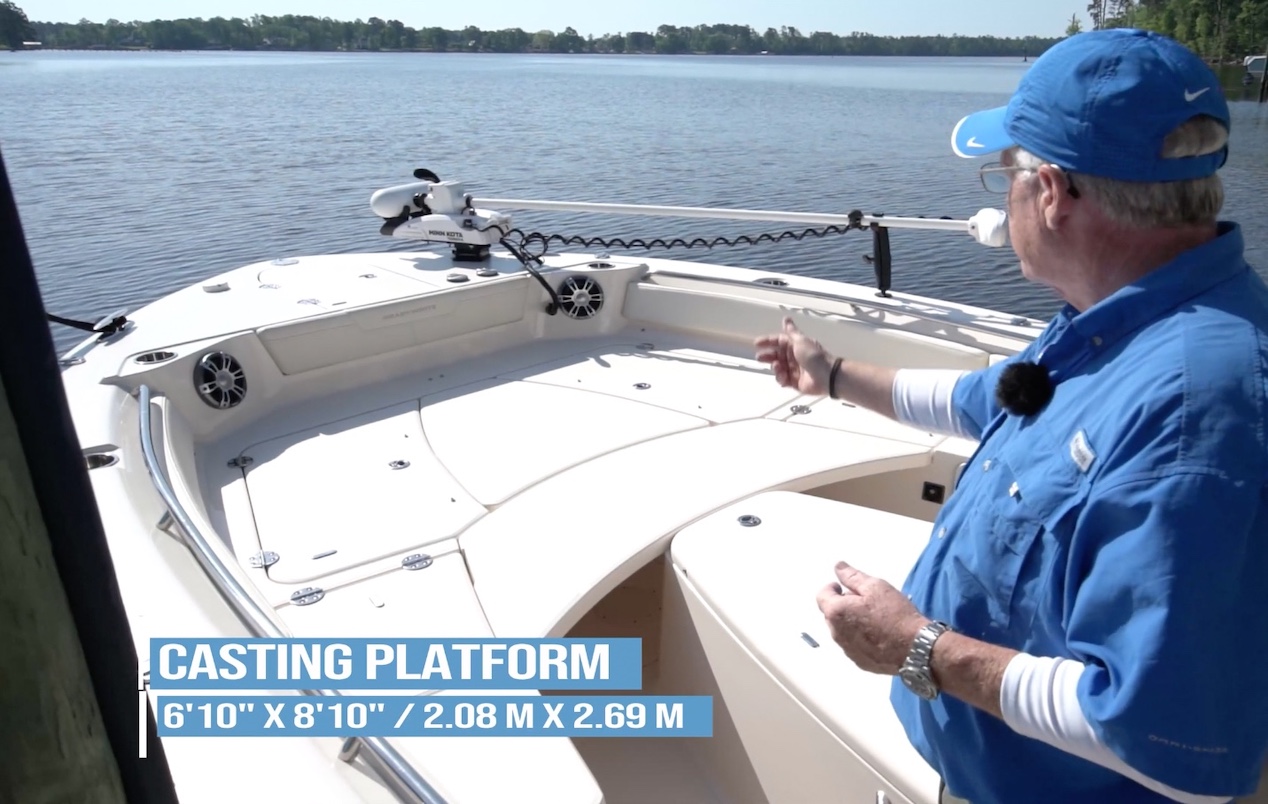
Above all, there’s a standard fiberglass T-top and it has a few tricks that separate it from the competition. First, it’s standard. Nearly every other center console will have an optional version. Everyone gets the option, but the base price of the boat is lower when it’s offered as an extra. Second, it’s fiberglass. How often do we see just a canvas tied to some pipe? The supports to this one are attached to the console rather than the deck, which would then take up valuable 22” (55.88 cm) side deck space. And there are added features such as LED lighting, rod holders, cargo net storage, painted supports and radar and outrigger reinforcements. Couple all that with an acrylic windshield that goes all the way to the top and it’s a giant leap over the competing brands.
Transitioning to family features, it starts with the 7’2” (2.18 m) transom bench seating. Now here is where some of that clever GW design thinking comes into play. All too often we see the flip-up bench seat that doubles as a casting platform. The problem with that is that because we need to keep the casting platform relatively low, the seating is far too low to be comfortable and the cushions have to be so thin that they are equally uncomfortable. Here, there’s storage under the seat and the cushions go on top. Now we have a comfortable solution. There’s a removable seatback in the center and two swing-in/out seatbacks to the sides. By swinging those seatbacks inward, we create a lounge seat across the transom. And all this can be under the protection of an electrically-extendable awning overhead.
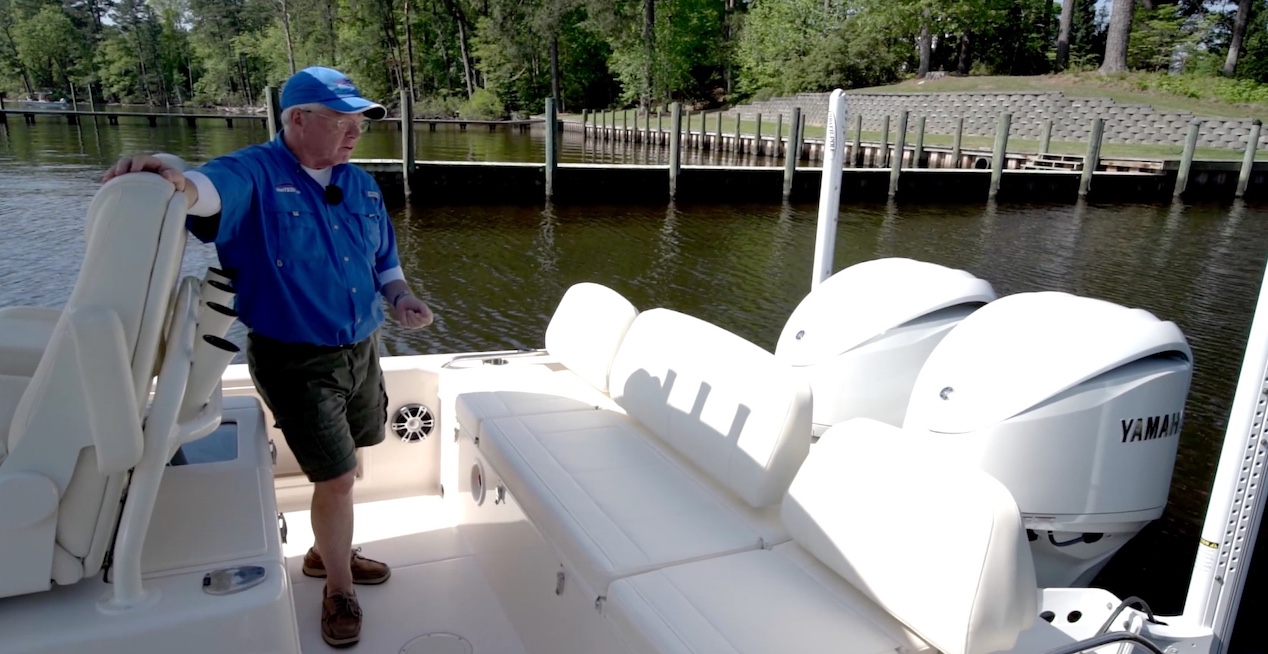


But the big news about this cockpit area has to be the hull side flip-out platform. We’ve seen these before on other boats, but Grady has a few significant twists on the concept. Firstly, it’s standard. How easy it would have been to make it an option to lower the base price of the 281 to make it more competitive in this strong market segment? But that’s not how GW conducts itself. Secondly, it’s electrically actuated. Typically, it’s not until a model gets a lot larger than the 281 before an electrically actuated platform enters the picture, but here it is in a sub-28’ (3.81 m) boat. There’s a reboarding ladder that inserts into receivers at the outer edge and this ladder had dedicated “point of use” storage right alongside the platform.

The bow seating transforms by simply adding cushions to the casting decks. This leaves us with a forward sunpad and a lounge ahead of the console that can hold two persons. The filler supporting the center cushion can be raised on a second pedestal to create a table between the two side lounge seats. Most notable is the lounge seat backs. They’re electrically actuated to chaise lounge positions and can be set at any angle from horizontal to 90 degrees at the touch of a button. That button could stand a move to a position where it could be reached from the lounge position. Currently, it’s a bit far aft.
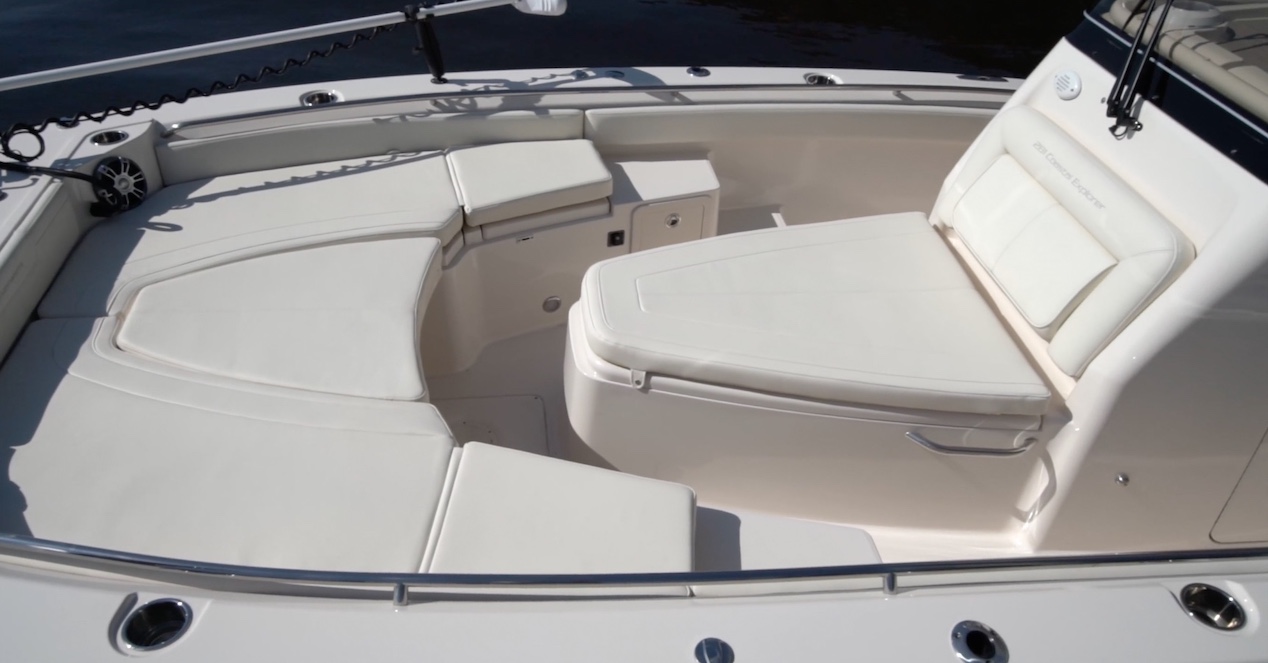

The comfort level is remarkable in these side lounge seats. There’s a convenient grab rail nestled inside the caprail and a beverage holder is right where the hand rests when the arm is on the caprails. Add the table right alongside and the picture is complete. For protection from the hot sun, add the optional “Easy Up” bow shade that gets supported by 4 carbon-fiber poles that are attached to the leading edge of the hardtop. Couple this with the extendable awning at the cockpit and the entire length of the 281 CE can be shaded.
The head compartment is accessed from the port side of the console. The door has a handle and mirror on the inside and it’s held open by a magnetic latch. When open it creates a 19” (48.26 cm) wide entry. A grab handle inside the door eases the entry and a light switch right alongside makes searching for a light source a non-event. The interior has 5’4” (1.62 m) of overhead clearance, which leaves 4’ (1.21 m) of sitting headroom. There are storage racks made from solid cherry. A side window adds natural light and a vent is overhead. Naturally, there’s also access to the back side of the helm console to ease installations of the electronics. And the side grab rail makes egress a breeze.
Safety is a big concern for Grady-White and they take it seriously. For example, regulations require that there be foam floatation for all boats less than 20’ (6.1 m) but Grady-White does it in every boat in the lineup. The boats are constructed with a grid stringer system for additional strength. And everything that can hold water… cup holders, storage lockers, the deck… everything is designed to drain overboard. Not into the bilge… overboard. There’s always something to grab onto as we move about including an overhead grab rail at the T-top that ends at midships where the bow rail begins. That rail tops out at 33” (83.82 cm).
The helm console has seen some upgrades. The most notable feature is the rows of electrical switches that lined the top of the console have been moved down. This allows for the twin 16” (40.64 cm) displays to be moved upwards, more in the operator’s line of sight. The displays are installed at the dealer level, GW is not in the electronics business, and that means that there are more choices for the buyer. A compass is center-mounted to the top of the console rather than in line with the operator. The 316 grade stainless wheel is portside mounted. It includes a steering knob and rubberized grips to the front and back side. The electrical switches are flanking a Yamaha engine display. There’s a wraparound acrylic windshield that is mounted outside the T-top supports and it goes all the way up to the fiberglass hardtop. A windshield wiper is also fitted as standard equipment. Seats are part of the Elite lean bar package and include flip bolsters, flip armrests and they adjust fore and aft. Standard would be a single bench seat.

Optional Equipment
- Choose from a single 425-hp or twin 300-hp Yamaha outboards
- Bow table package
- Casting platform extension insert w/cushion
- Engine paint — Yamaha factory-painted engine(s), pearlescent white (300 and 425 HP) or primer (425 HP only)
- Hull color — Celestial Blue, Coastal Fog, Ocean Mist, or Sea Glass gelcoat
- Lighting — underwater blue LED (2)
- Outrigger kit —18-ft. (5.5 m) crank hardtop mounted stainless steel outriggers w/carbon fiber poles
- Seating — Elite lean bar w/Command Elite helm chairs (2), painted rod holders (4), 38-gal. (144 L) insulated raw water livewell, freshwater shower (recessed), raw water washdown w/hose, bait locker, cutting board, lockable storage drawers (3), tackle storage, port net storage area & knife & plier holders
- Seating — removable aft bench seat center backrest
- Ski arch (only available w/single 425-hp engine)
- Ski pylon (only available w/twin 300-hp engines)
- Steering — Helm Master EX® Full Maneuverability w/autopilot
- SureShade® electrically retractable cockpit shade w/Sunbrella® canvas (oyster)
- T-top color — underside of fiberglass T-top (requires matching gelcoat hull color option)
- Trolling motor pre-rig — swivel mounting bracket w/quick release, head stabilizer, 36V batteries (3) and 20-amp battery charger (trolling motor not included)
- Easy up bow shade (ivory mesh)
- T-top wing curtains (black or ivory)
Price
Please see dealer for pricing
Observations
It’s refreshing and satisfying to see how well the concept of a center console can be executed when some out-of-the-box thinking is applied. This is one of the more premium levels out there and her features are right in line with that upscale level. It’s also nice to see how so many clever features can be added into the mix without making the boat cramped or hard to get around on. This seems to have everything done right. And that’s the Grady-White difference.

